Why the LED bulbs blink: troubleshooting + how to fix
Today, people are massively switching to the use of energy-saving lighting devices. This is being done with the hope of gaining a number of important advantages, including profitability and durability.
But it often happens that instead of the expected result, users immediately encounter signs of malfunction. Therefore, the question of why LED lamps are blinking arises quite often before the consumer.
In this material we will consider all the most common causes of LED lamps blinking, and also talk about ways to find a malfunction in lighting equipment.
The content of the article:
Why do cheap lamps flicker?
Probably, there are no longer people who have not heard that it is not worth buying cheap products from little-known manufacturers, as this is fraught with negative consequences of varying complexity.
This also happens in the case of LED lamps, which often even immediately after a purchase begin to flash, which does not please the owners at all.

But this mode of operation in most cases does not indicate a breakdown. That is, the lighting device is usually operational, but it is exposed to any adverse factors that impede normal functioning.
And if they are eliminated, then the flicker will stop, and there will be no relapse. But it’s more practical to prevent such phenomena and all that is needed is to purchase quality products from well-known manufacturers.
At the purchase stage, they will cost more, but high performance will ensure long-term operation. And without losing the best properties, but it is expensive. Since cheap lighting devices allow you to save only on price.
And then a person is faced with their predisposition to various malfunctions and other negative consequences, including negative health effects.
Modern LED lamp they are always sophisticated technological devices consisting of many components. Among them is a driver whose task is to stabilize electric current.
And this is an important task, since high-quality and long-term work depends on its characteristics, and not on stress, as many believe.
Additionally, the driver is able to cope with various side factors leading to flicker in the on / off position of the switch.
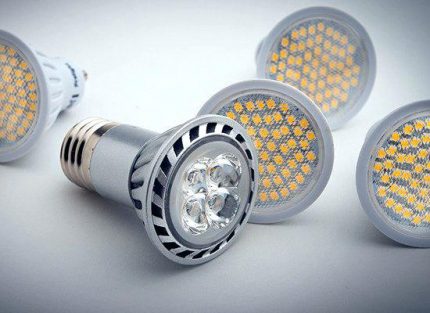
But it is an indispensable part of the design of only high-quality and, therefore, expensive lamps. And in their affordable counterparts of Chinese and even domestic origin, to save money, this key element is always replaced with a cheaper power supply.
It is based on such structural elements as a diode bridge equipped with a capacitive filter and a quenching capacitor. Which are able to provide high-quality lighting only when the characteristics of the electric current are ideal.
In this case, the duty cycle is as follows:
- Initially, alternating current passes through a diode bridge, where it is converted to a constant, but with high ripple, constant voltage for LED lamps.
- To give the electric current stable characteristics, it is fed into a capacitive filter. And from there to the quenching capacitor, which finally smooths out the ripple.
- Current with the necessary characteristics goes to the lighting devices, allowing them to carry out their duties regularly.
But with non-ideal parameters of the electric current, the power supply unit with its cheap components is not able to cope with the ripple and its rectification, which ultimately causes blinking.
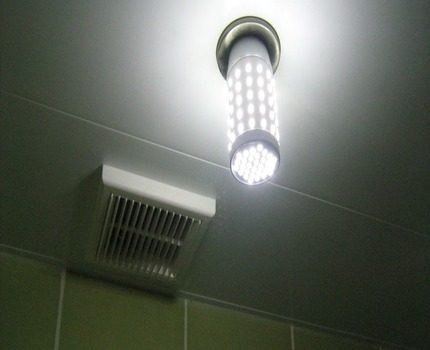
In addition, signs of such a malfunction can occur both in the off and on state.
And you should know the features of each kind of contingency work, as this will help eliminate the defect. Moreover, quickly and often without any serious costs.
Blinking when the switch is off
This type of malfunction manifests itself due to the fact that the electric current, even when the control is inoperative, enters the smoothing capacitor.
There, it accumulates and when filling the entire available volume, it enters the start-up circuit, which tries to bring the LED lamp into working position.
But a tiny supply of electricity is only enough for a short flash. Further, the procedure begins in a new way and can continue until the cause or failure of the lighting device is eliminated.
Reasons for abnormal work
The blinking frequency can be different and depends on the amount of electric current passing through the power supply unit of a cheap lamp.
But you need to understand that this is not a cause, but only a consequence of the malfunctioning of other elements of the chain. And they should be known to cope with the task, and without unnecessary costs and loss of time.

Despite the signs of malfunction, the product, in most cases, remains operational. It’s just that the power supply is not able to prevent instability by smoothing out the ripple.
One of the LED lamps flashes due to the following irritants:
- switch backlight;
- induced voltage;
- presence of leakage currents.
Since knowledge of the signs of the cause of the malfunction will help to identify them and quickly eliminate them, you should deal with each of them separately. Moreover, it will be possible for a user far from this sphere.
Flashing due to switch backlight
For convenience, many manufacturers equip their switches with backlight. And in most cases, they benefit by increasing the comfort of the owners, as they are easier to find in the dark.
But when using such a control element together with low-cost lamps, the current supplied to the LED backlight can cause a blinking. This happens because the indicated structural element is connected in parallel with the switch itself.
This feature leads to the fact that in the on position, all the electric current goes to the power of the used LED lamps, and in the off position it provides illumination.

At the same time, a small amount of electricity can get further to the capacitive filter and the quenching capacitor, and then, after reaching the desired performance characteristics, it gets to the lamps, causing blinking.
Moreover, this reason is the most common, so the user should always remember about it. And when restoring the functionality of lighting in the room, attention to switch backlight always worth paying, and in the first place.
Induced voltage blinking
In the post-Soviet space, they often like to save on quality. That induced voltage is a consequence of this. Since most often it occurs when several multicore wires are used to power several devices, and not several, as expected.
Although it sometimes happens that when laying independent power lines in a single gate, interference can also occur due to the induced voltage.
But this only happens in disconnected areas. And usually the wiring has the effect, which powers electrical appliances operating under heavy load.

And although such interference is insignificant, there are enough of their capabilities to influence LED lamps. Which, as a result of active exposure, begin to flash often, which leads to their rapid failure.
And the worst thing is that a lighting fixture purchased as a replacement will encounter the same negative factors.
When do leakage currents create a problem?
This reason is the most serious of all possible. Since abnormal operation of any LED lamps can be caused by quite fire-hazardous reasons.
These include:
- improper or poor quality wiring;
- damaged or collapsing insulation;
- bad contact.
Often, when performing work, the human factor exerts its influence and specialists violate all kinds of elementary rules.
As a result, after breaking the circuit, that is, when the switch is set to the inoperative position, the current still flows to electrical appliances. This happens if zero is confused with phase.
Damage to the insulation can occur due to careless handling of the wire during installation or operation. In addition, it often loses its performance after prolonged use, that is, when its resource has been exhausted.
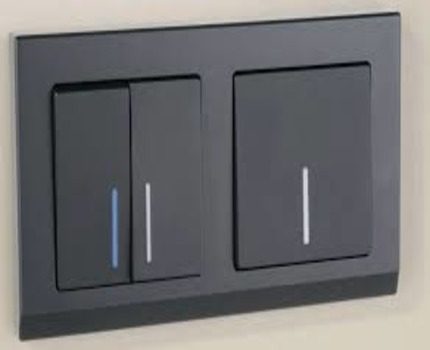
Another cause of leakage currents is poor contact between wires and other circuit elements. This happens even with ordinary oxidation, which can happen several years after the start of their use, and in difficult conditions even faster.
Ways to eliminate the causes of blinking
If the flashing occurs due to the presence of a backlight, then the easiest way to restore normal operation will be to break its circuit. That is, you need to dismantle the switch and just have a bite to eat the necessary wires.
This will not affect the characteristics of the appliance, but the backlight will not function in the future. In addition, a simple method is to replace the circuit breaker - this can be done promptly.
And also you should know that there are two types of backlight: neon and LED. And when using the first, flicker is much less common - this is information for those who do not want to complicate the search for a switch in the dark.
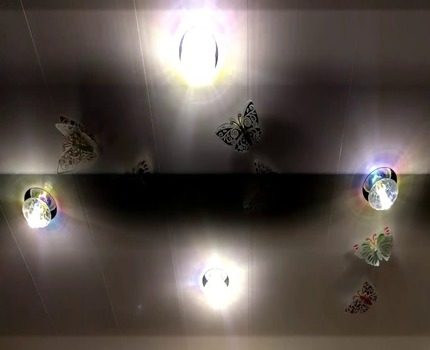
If you use a group of LED light sources, then instead of one of them you can install the most low-power incandescent lamp. It will work as a resistor, turning current into heat and dissipating it into air.
Thus, flicker can be avoided, but the aesthetic properties of the chandelier will deteriorate significantly. Since in most cases an incandescent lamp will not be able to disguise.
Another proven option to eliminate the causes of abnormal work is to add a low-power resistance of 50 kΩ to the circuit at a power of 2 watts.
But it should be understood that such an element increases the fire hazard. Therefore, the work must be done with high quality and no less responsible attitude to the isolation of contacts.
The effects of induced voltage are most often eliminated by the above methods. But it happens that the signs of malfunctioning do not disappear.
For example, sometimes you can observe flashing even after replacing the switch with an analog without backlight. In this case, only replacing the cable will be an effective option, and if there are several of them, then it will be necessary to place them at some distance from each other.

Leakage currents are eliminated only by checking the correctness of the wiring and correcting deficiencies, that is, replacing the circuit elements in poor condition.
In the most difficult case, you will have to perform a wiring replacement in the entire apartment. This is especially true in cases where a long-outdated and ineffective grounding system TN-C is used in a room with a flashing light, which does not exclude the possibility of electric shock to a person.
Blinking when the switch is on
In this case, there can be only two reasons, so it is easier for the user to find and eliminate them. But you should remember that you need to do this quickly, since the durability of LED lamps depends on this.
Causes of blinking may be as follows:
- weak stress;
- poor quality power supply.
All LED lamps are sensitive to low voltage, but high-quality instances with a driver instead of a power supply can work stably within 180 V. Then, as the economy options completely stop working - they go out, they just do not turn on - already at 200 V.
And, if the voltage is slightly higher, but does not reach 220 V, then the user will observe a flicker with a different frequency. Moreover, it will stop when the network parameters stabilize to normal.
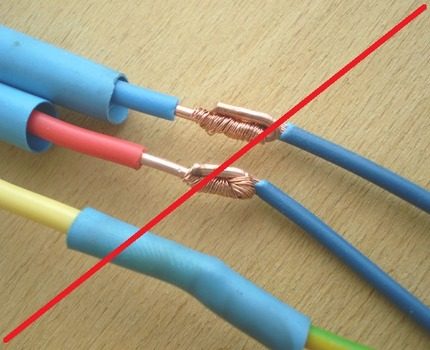
Also, a malfunction can occur when trying to dimming an LED lamp not intended for this. At the same time, its performance at the maximum position of the dimmer will be normal, and when you try to reduce it, flickering will begin.
Instructions for connecting the dimmer can be found in this stuff.
If the voltage in the network turns out to be normal, then you should pay attention to the power supply of the product used. The reason, as described above, may be because its components simply cannot smooth out the ripple of the current, which leads to blinking.

In order to prevent abnormal operation in any of these cases, you can install stabilizer, which will provide the current with the necessary parameters, and at the same time prevent early breakdowns of electrical appliances used by the owner.
If the voltage is normal and the reason is low-quality components of the power supply, then the user will be able to upgrade it. To do this, it is necessary to replace the installed smoothing capacitor with a more powerful one, and an advanced user will be able to independently assemble a reliable driver.
Moreover, this characteristic is limited not by parameters, but by the size of free space in the power supply unit, lamp base. That guarantees smoothing of a pulsation of current and will provide stability to its parameters.
How to find the reason?
Each user must remember that the speed of his actions to eliminate blinking is very important. Since any LED lamp has a resource for inclusion, which can be developed in just a few days.
In addition, if the wiring is damaged or its insulation can be hazardous to human health.
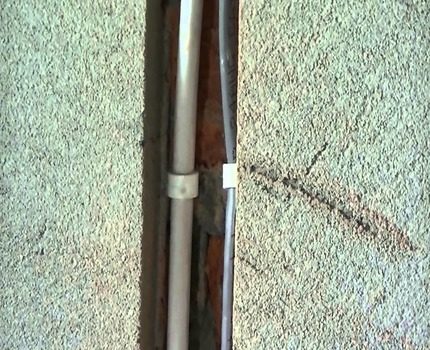
The search itself must be started by checking the correct connection of the phase wire. It must always be connected to one of the switch contacts.
If it turns out that the current is coming to the backlight, then this will cause blinking. Checking can be done using an indicator screwdriver, which everyone can do.
When this stage is passed, and the malfunction is not resolved, you should replace the switch with a similar product without backlighting, mount a low-power resistance or use an incandescent lamp. If the flicker has stopped, then we can assume that the person coped with the task.
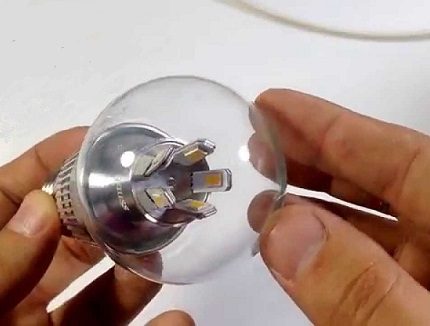
But, when the malfunction reappears, a wiring inspection should be performed to identify damaged insulation, oxidized contacts, a series of power cables and other problems.
Which will need to be eliminated even if such operations prove to be labor-consuming and expensive. Since only this can guarantee the absence of danger to human health.
If flickering occurs in the on position of the switch, then the voltage and its stability are initially checked.
When the parameters are normal, you should replace the LED lamp with a high-quality analogue of a well-known manufacturer.Which are the high-tech products of OSRAM, Philips and several others.
Conclusions and useful video on the topic
How to restore the lamp performance by installing a resistance is demonstrated in the video:
The following video provides an overview of several other ways to eliminate the flashing of all kinds of LED lamps:
The flashing of LED lamps is a very common phenomenon and you do not need to be afraid of it, since in most cases it is easy to eliminate. In most cases, just change the switch.
But the very manifestation of such a flaw indicates that cheap and low-quality products are used that do not inspire the confidence of manufacturers. And imaginary savings cost extra costs and wasted time.
If you have the necessary experience or knowledge, please share it with our readers. Please leave your comments, ask questions in the block below.

 Why LED lamps light when the switch is off: reasons and solutions
Why LED lamps light when the switch is off: reasons and solutions 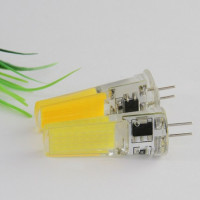 LED bulbs g4 to 12v: features, rules of choice + review of the best manufacturers
LED bulbs g4 to 12v: features, rules of choice + review of the best manufacturers  LED lamps for the home: which diode bulbs are better, LED lamp manufacturers overview
LED lamps for the home: which diode bulbs are better, LED lamp manufacturers overview  Which bulbs are best for the home: which are + rules for choosing the best bulb
Which bulbs are best for the home: which are + rules for choosing the best bulb  LED lamps "Feron": reviews, pros and cons of the manufacturer + best models
LED lamps "Feron": reviews, pros and cons of the manufacturer + best models 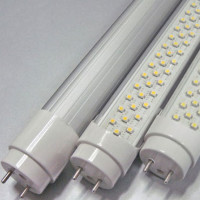 Replacing fluorescent lamps with LEDs: the reasons for the replacement, which are better, replacement instructions
Replacing fluorescent lamps with LEDs: the reasons for the replacement, which are better, replacement instructions  How much does it cost to connect gas to a private house: the price of organizing gas supply
How much does it cost to connect gas to a private house: the price of organizing gas supply  The best washing machines with dryer: model rating and customer tips
The best washing machines with dryer: model rating and customer tips  What is the color temperature of light and the nuances of choosing the temperature of the lamps to suit your needs
What is the color temperature of light and the nuances of choosing the temperature of the lamps to suit your needs  Replacement of a geyser in an apartment: replacement paperwork + basic norms and requirements
Replacement of a geyser in an apartment: replacement paperwork + basic norms and requirements
I ran into the problem of flashing LED lights. At first, he sinned on the dimmer, because it was worth turning it on full, and if the blinks did not stop completely, they became less frequent. But in the night light mode the situation was constantly worse. I tried to connect without it, but failed to completely fix the problem. Then the father-in-law advised to buy light bulbs more expensive. And you know, it helped. So, first of all, you should try to change the model of the light bulb, buy a better one. If it does not help, then climb further.
I always thought that the cause of a blinking light bulb is voltage drops or faulty wiring. Because the house is old, then this is not surprising. If the light bulb started to “fool”, then simply threw it out and bought another. It did not occur to me that there could be such different and complex reasons, and indeed that they can be corrected independently.
Next time in case of problems, I’ll try not to throw it away, but to figure it out.
Hello! Need qualified advice. I have a linear 220 V LED, it starts blinking after turning on. 20-30 minutes, as it were, "accelerates or warms up," and then shines at full strength. Having read on the internet, I think that the reasons are in the smoothing capacitor of the driver, if I understood correctly. There are two on the capacitor in the driver: 1 at 22 µf at 400v and 2 at 2.2 µf at 400v. They write on the internet that this can be fixed by installing a larger capacitor.
So, the question is:
1. Which one is smoothing?
2. Is it possible to attach the same to it in parallel, thereby increasing the capacity by 2 times? In general, can this be done and will it help?
I would be grateful for your reply. Thanks in advance.
P.S. There is no backlit switch. According to the scheme, the switch stands correctly - in the phase break. I can send a photo of the driver to your mail.
Good afternoon, Vladimir Viktorovich. I will not theoreticalize - just attach a screenshot of the driver circuit. A smoothing block “capacitor / resistance” is highlighted there. In the course of the current, it is at the beginning of the chain. In your driver, it is located similarly.
On the 2nd question - take a screenshot of the circuit and assume that the capacitor is shorted (broken).In this case, it simply shunts the resistance and will bypass the solid capacitor soldered by you.
It will be more correct to check the serviceability of the existing capacitor with a multimeter. Examine it first - there may be traces of damage to the shell. Then you can immediately solder it and change it to working.